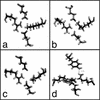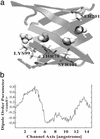Developing an energy landscape for the novel function of a (beta/alpha)8 barrel: ammonia conduction through HisF
- PMID: 12799468
- PMCID: PMC164632
- DOI: 10.1073/pnas.1331150100
Developing an energy landscape for the novel function of a (beta/alpha)8 barrel: ammonia conduction through HisF
Abstract
HisH-hisF is a multidomain globular protein complex; hisH is a class I glutamine amidotransferase that hydrolyzes glutamine to form ammonia, and hisF is a (beta/alpha)8 barrel cyclase that completes the ring formation of imidizole glycerol phosphate synthase. Together, hisH and hisF form a glutamine amidotransferase that carries out the fifth step of the histidine biosynthetic pathway. Recently, it has been suggested that the (beta/alpha)8 barrel participates in a novel function: to channel ammonia from the active site of hisH to the active site of hisF. The present study presents a series of molecular dynamic simulations that investigate the channeling function of hisF. This article reconstructs potentials of mean force for the conduction of ammonia through the channel, and the entrance of ammonia through the strictly conserved channel gate, in both a closed and a hypothetical open conformation. The resulting energy landscape within the channel supports the idea that ammonia does indeed pass through the barrel, interacting with conserved hydrophilic residues along the way. The proposed open conformation, which involves an alternate rotamer state of one of the gate residues, presents only an approximately 2.5-kcal energy barrier to ammonia entry. Another alternate open-gate conformation, which may play a role in non-nitrogen-fixing organisms, is deduced through bioinformatics.
Figures





References
-
- Jiang, Y., Lee, A., Chen, J., Cadene, M., Chait, B. T. & MacKinnon, R. (2002) Nature 417, 515–522. - PubMed
-
- Jiang, Y., Lee, A., Chen, J., Cadene, M., Chait, B. T. & MacKinnon, R. (2002) Nature 417, 523–526. - PubMed
-
- Tajkhorshid, E., Nollert, P., Jensen, M. O., Miercke, L. J., O'Connell, J., Stroud, R. M. & Schulten, K. (2002) Science 296, 525–530. - PubMed
-
- Rhee, S., Parris, K., Ahmed, S. A., Miles, E. W. & Davies, D. R. (1996) Biochemistry 35, 4211–4221. - PubMed
-
- Miles, E. W., Rhee, S. & Davies, D. R. (1999) J. Biol. Chem. 274, 12193–12196. - PubMed
Publication types
MeSH terms
Substances
LinkOut - more resources
Full Text Sources

